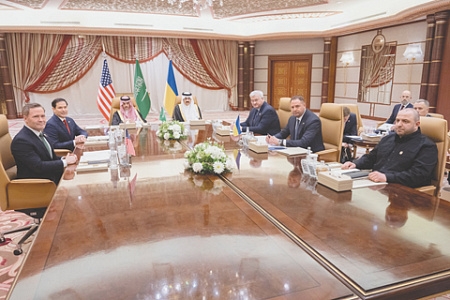
A series of negotiations began with the meeting of the US and Ukrainian delegations in Saudi Arabia, which, according to Donald Trump’s idea, should culminate in peace between Moscow and Kiev. Trump is going to get mutual concessions from Russia and Ukraine. But it seems that his vision of what the world should look like is not yet fully shared by either side.
Trump had high hopes for the talks in Jeddah, Saudi Arabia. “Ukraine wants to make a deal because I don’t think they have any other choice. I believe Russia also wants to make a deal,” the American president argued.
Earlier it was reported that on the part of the United States, the same people who spoke with the Russian delegation in Riyadh in February will take part in the talks in Jeddah: Secretary of State Marco Rubio, Assistant to the President for National Security Michael Waltz and the president’s special representative for the Middle East Steve Witkoff. However, the journalists saw only two of them at the negotiating table. Witkoff was not there. Bloomberg reported, citing its sources, that Witkoff has an important mission planned. Allegedly, he is going to arrive in Moscow this week and meet with Vladimir Putin. Neither the White House nor the Kremlin confirmed this at the time of signing the issue.
The composition of the Ukrainian delegation has also changed. President of Ukraine Volodymyr Zelensky has arrived in Jeddah. He did not appear in the meeting room, but, undoubtedly, the Ukrainian delegation kept in touch with him. On the Ukrainian side, head of the Presidential Office Andriy Ermak, his deputy Pavel Palisa, Minister of Foreign Affairs Andriy Sibiga and Minister of Defense Rustam Umerov participated in the negotiations.
Ermak, Sibiga and Umerov were sitting at the table. Three hours after the discussion, the head of the office of the Ukrainian president found it necessary to post two flags on Telegram, Ukrainian and American, accompanied by a note: “Work continues.” Waltz, who left the room at about that time, also limited himself to a brief remark in response to questions from reporters: “The work is progressing.”
Negotiations had not ended at the time of signing the number. Judging by what was stated on condition of anonymity or openly by people from the Trump team, the meeting in Jeddah will be only part of the negotiation process with Ukraine. “I’m not going to set any conditions, to say that Ukrainians should do this, they shouldn’t do that. We want to hear what they are willing to agree to, and then compare it with what the Russians want, and compare how the positions of the parties do not match,” Rubio outlined his task in a conversation with reporters on his way to Jeddah. This is generally similar to what he stated after the February talks in Saudi Arabia with the Russian delegation. At that time, he called the meeting with representatives of the Russian Federation “consultations leading up to negotiations.” However, it is unclear what prevented Trump from finding out the Ukrainian position directly from Zelensky. They are known to have met on February 28 at the White House, and that meeting ended in a scandal. Zelensky then said he was ready to talk to Trump again. But, apparently, this method of communication seemed unacceptable to the American president.
Meanwhile, during the same conversation with reporters, Rubio said that the outcome of the negotiations in Jeddah depends on whether Trump will resume the supply of American weapons to Ukraine. According to the Secretary of State, this is possible “only if we report to the president on the good result” of the meeting.
An anonymous American official made an important comment to the Reuters news agency. According to him, following the talks in Jeddah, Trump wants to clarify “whether Ukrainians are ready not just for peace, but for a realistic peace.” That is, is Ukraine, in particular, willing to move away from the requirement to return to the borders of 1991 and discuss other scenarios?
The Financial Times reported that the Ukrainian delegation actually gathered in Jeddah to propose an Anglo-French truce scenario, the one previously proposed by British Prime Minister Keir Starmer and French President Emmanuel Macron. The scenario involves a cease-fire at sea and in the air and a ban on strikes by long-range missiles and drones deep into the territories of Ukraine and Russia. The newspaper did not report whether the Ukrainian proposals include the deployment of any peacekeepers to the conflict zone.
European officials, for their part, have drawn red lines that they believe Ukrainians and Trump should adhere to. For example, French Defense Minister Sebastien Lecorny said that the demilitarization of Ukraine, which Russia insisted on back in 2022, is excluded and cannot be negotiated. And Dutch Defense Minister Ruben Brekelman said that Zelensky should not agree to conditions that do not guarantee lasting peace, but only provide the Russian Federation with a respite before resuming hostilities.
* * *
The statements of the negotiators were monitored by Russian Telegram channels.
“Ukraine needs to be given security guarantees, Europe should put more pressure on Russia with sanctions and not give back frozen assets, and Europe should also be more independent in terms of security. These are Ermak’s main theses in the Guardian. From these theses, it is clear that Europe has now become Kiev’s last hope against the background of a change in the US position,” Temnik writes.
“The Americans will surely come up with means to monitor the implementation of the deal and firm guarantees (at least, approval by the Rada). And minerals are already scarce – Washington is not only demanding concrete steps towards peace, declaring the inevitability of territorial losses by Ukraine, but also the transit of power,” the Meister notes.
